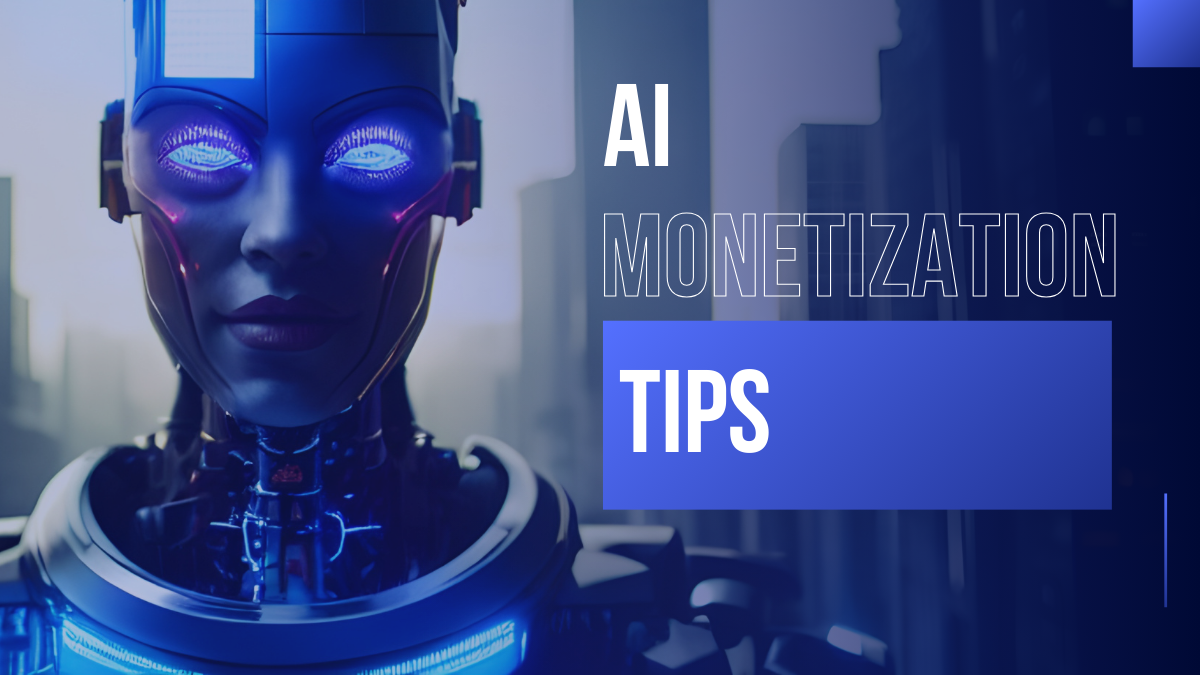
Artificial Intelligence and Its Potential in the Digital Economy :-Ai Monetization is no more a topic of a discussion for technocrats and scientists it has rather a common trend nowadays used in almost every field possible. Everywhere from the medical industry to banking, technology from entertainment to education AI Monetization is changing how companies function and achieve. This is important in the context of AI’s continued encroachment in people’s everyday existence – where and how should it be monetized? AI can serve as a multi-billion-dollar market or being a key attribute that can significantly bolster the top-line: these are the two potential strategies that businesses consider when it comes to artificial intelligence. Here I will outline how the monetization of AI works, what strategies are used, the problems and prospects that await AI-based business models.
Table of Contents
1. Understanding AI Monetization
AI monetization is therefore the ability to assign value with a monetary equivalent to AI technologies, applications, and services. It can be done directly through sales of AI products, through AI based subscription services, provision of analytics based on collected data, etc. The aim is to harness AI features including the ability to automate, predict, perform NLP and ML to deliver customer value for a fee.
Monetization of AI is thus more than a simple product to market proposition; it involves packaging of Ai Monetization as a fundamental element of a much larger solution offer. It may mean incorporating AI in existing products, creating new products that are based on AI solutions, or applying AI in offering better customer value.
2. AI as a Product: AI Solutions Marketing
Another way of monetizing AI is through marketing and selling of products or services that are however, infused with Ai Monetization. They can be individual AI solutions as well as integrated solutions that complement an existing product.
a. AI-Powered Software
One of the most common productions of AI is AI-powered software, which can be found in the market widely. They use Ml algorithms, NLP, and data analytics to provide superior features in these solutions. Some examples of such tools are: Artificial Intelligent customer relationship management (CRM) systems, Fraud prevention and detection, Predictive maintenance, and other analytical business tools.
b. AI as Service or AIaaS
AI as a service (AIaaS) can be defined as the provision of AI tools and platforms as a delivered service. This enables organisations to leverage AI capacities without the need to commit resources in putting up structures and people that develop AI focused solutions. IBM, Google, and Amazon are some of the firms that offer AIaaS, which include, machine learning tools and data analysis/NLP.
AIaaS makes the use of high-end AI effectively affordable by all sizes of business and hence opens up new sources of revenue for providers of AIaaS.
3. Data Monetization: AI-Enabled Deployment of Insights
We have heard the term, ‘big data’ and data is often compared to oil and AI is the processing plant for this raw material. Leveraging through Ai Monetization, those firms that possess huge volumes of data can turn this intangible pool of information into a cash-generating stream by providing analytics services to others or employing the insights harvested, in turn, for their business advantages.
a. Selling Data-Driven Insights
AI may be used by firms in capturing large volumes of data and presenting this in a form of an analysis service. For instance, a business organisation that monitors consumer habits could feed the data to an AI model that analyses trends, and then sells back its findings to other firms. Nielsen, a worldwide business that specializes in measurement and data, offers AI to view customer conduct and offer data to retailers, advertising agents, as well as media houses.
b. Enhancing Decision-Making
AI-enhanced data analysis can also be sources of revenue by enhancing decisions-making in organisations. For example, the use of decision-making or predictive analytical functions in employing and training employees, in credit granting or in investment decisions in financial institutions. In this way, such institutions will have an opportunity to bring novel sources of income by including AI in their advisory services.
4. AI-Driven Personalization: Addition, improves customer experiences
Thus, personalization can readily be noted as a potent weapon in the fight for greater customer engagement. It is another tool that can achieve large-scale, highly customized experiences of brands, which engages and, thus, sells.
a. E-Commerce Personalization
Thus, implemented in the e-commerce industry, artificial intelligence is capable of driving the sales beyond the limits. Ai Monetization harnesses the behavior by customers to suggest products, customize advertising and, at times, even set rates for the products. Amazon for instance uses an intelligent system to suggest the products that the user is likely to buy depending on; their browsing history, buying history, and other facts.
b. AI in Content Recommendation
The AI-based content recommendation feature which is intrinsic to every streaming service, is best highlighted by Netflix and Spotify. These platforms have the ability to determine and recommend, based on the users’ proclivities, movies, TV shows or even music track that he/ or she will find interesting. This also improves the user experience and hence results in the users spending more hours on the platform; a factor that can be exploited to generate more cash through subscriptions or advertisement space.
5. Subscription Models: AI-Powered Services as the Source of Subscription-Based Revenue
Of these techniques, the most commonly implemented strategies are through subscription services. Since AI tools and solutions can be made available frequently in the market, the main advantage of offering them on subscription mode is the creation of a steady stream of revenue for the companies while giving continued value to the consumers.
a. SaaS with integration of Artificial Intelligence
It is now standard to find Software as a Service (SaaS) solutions that have AI components as parts of the offering. These platforms provide businesses an always on, access to advanced features belonging to the Ai Monetization category like analytics, automations and customer service chatbots. With the help of this type of revenue sharing, the stream of money is more stable as clients can receive regular updates of better products.
b. AI-Enhanced Platforms
Most applications such as HubSpot or Adobe Creative Cloud, have AI as part of the premium versions of the software. For instance, Ai Monetization is applied in tools used by HubSpot for identifying the best approaches for a marketing campaign, or in adobe designing applications where AI is used to complete repetitive tasks as well as suggest designs.
6. AI in Advertising: Targeted Marketing as well as Programmatic Advertising
Marketing is one of the most crucial revenue sources of the digital platform and Ai Monetization is again changing the marketing tactics to smarter one.
a. Programmatic Advertising
Programmatic advertising is the kind of advertising that employs Artificial Intelligence in the buying and selling of ad space with a view of reaching the right audience at the right time. It optimises ad spend returning high value of advertisements for the advertisers involved. Companies such as Google and Facebook for instance have created immense business models / platforms through Adwords and Facebook advertising which depends on machine learning to put advertisements based on users’ activities.
b. Personalized Ad Campaigns
Ai Monetization can also be applied for targeted ads; it is possible to guess who is interested in this or that particular product. AI also help to figure out which message is suitable for which audience, and when and via which media is it better to send it. Such targeting raises the chances of conversion, which makes the ads more successful and hence profitable in this level.
7. AI in Customer Support: Chatbots and Virtual Assistance
The pop up of intelligent and natural language processing in the form of chatbots and virtual personal assistants makes customer support much more effective and efficient in handling customer questions. These tools enable high throughput in terms of the number of request at a given time making it easy to do away with human beings and therefore cutting on costs.
a. Making Money from AI-Based Customer Care
Companies might even have a basis for profit in AI tools that are designed for customer support; these tools and programs can be part of a package service offering. For example, Zendesk and Freshdesk offer their customers Ai Monetization solutions in the form of chatbots included in customer support systems, offering businesses more elaborate means of boosting the quality of their customer relations.
b. AI Based Upselling and Cross Selling
Ai Monetization chatbots may also be designed to suggest to a customer other related products in a given selling channel. From the customer data these bots are able to suggest to the customer other products or services that they may be interested in thus enhance the revenues.
8. AI in Financial Services: Automated Trading and Automated Financial Advising
The financial industry one of the first industries where Ai Monetization has been implemented for operational enhancement and to find new business models.
a. Algorithmic Trading
Algorithmic trading is the utilisation of artificial intelligence in making trades at rates and in volume beyond human capability. Machines acting as traders use algorithms to draw insights on the market at the real-time level and make an immediate trading decision in terms of purchasing or selling a certain type of asset depending on specified parameters. Such an approach can indeed bring large revenues at high-frequency trading environment.
b. Robo-Advisors
Robo-advisors are another great invention in the field of Financial services and technology founded on Ai Monetization. These are internet-based personal financial planning platforms, which offer computer-generated, model-based planning and advisory without the involvement of a human planner. Since robo-advisors assist those interested in a more affordable recommendation of their portfolio investment and a wider pool of consumers, the financial institutions will generate new revenue.
9. AI in Healthcare: Diagnostic, Patient-Tailored Therapy, and Beyond
The use of artificial intelligence in healthcare industry is growing rapidly owing to radical changes they bring by dissecting huge chunks of medical data in order to differentiate between the right diagnosis and right treatment plan.
a. AI-Powered Diagnostics
Computer technologies can help to identify patterns in diagnostic images, tests, and patients’ record to help the doctors provide their patients with the correct diagnosis. For instance, IBM’s Watson Health is applied to make diagnosis and treatment recommendations out of clinical information. The former can be converted to income-generation tools to the healthcare providers via service charges while the latter can be incorporated into large health care structures.
b. Personalized Medicine
It is also being used in cases such as that of personalised medicine, where the treatment to be offered depends with the genetic makeup of the person plus other factors. Firms such as 23andMe and Ancestry. Integrated application of AI on human related information by companies such as 23andme. com business has created business models based on computer analysis of consumers’ DNA and genetic markers, DNA testing that reveals consumers’ ancestry and risks factors to diseases.
10. AI in Manufacturing: They include automation, and predictive maintenance.
In the manufacturing sector AI is more applied towards reliability improvement, reducing down time and enhancing production.
- Automation and Robotics
At the moment, artificial intelligence is managing robots and automatons that, in effect, take jobs with simple repetitive motion responsibilities away from people and force the robots to work nonstop, without ever getting tired. This in effect leads to large savings on costs and increase efficiency. Some of the activities that industries for example Tesla, have adopted include: utilization of Ai Monetization in production line with a view of reducing some of the errors that may be made.
b. Predictive Maintenance
This is the same as applying artificial intelligence in analyzing data from machinery and making a prognosis of when it will be needed to be serviced and should be serviced on the basis of data collected rather than waiting for a failure to happen. This assists to prevent failure and as a result reduce on the maintenance costs hence being a service that can attract a fee through subscription or through performance contracts.
11. Challenges in AI Monetization
As we shall see, the opportunities are enormous; however, the threats that adorn the attempt to Ai Monetization are also enormous.
a. Data and Security: This includes issues to do with privacy and ethical practices.
Maybe that is why the question about data privacy is one of the most burning in connection with the monetization of Artificial Intelligence. Since AI uses data to function then the businesses must ensure that the data of the customers is processed responsibly and with compliance to GDPR. If not done, the repercussions are legal consequences and undesirable consequences as per the image of the brand.
b. High Initial Investment
A number of AI projects require first-time capital investment in technology, people and facilities to a very significant extent. This can turn into a problem for such small firms or start-ups, which may wish to enter the AI market. However, this remains an issue, although not as troublesome thanks to the interaction with the cloud and open-source solutions for services and tools for Ai Monetization.
c. Complexity and Technical Expertise
AI technologies are complicated and the entail skill and knowledge for one to be able to implement them and maintain. This is can be problematic for a company that may not have resources to hire expert personnel in the field of AI particularly in monetising the same. This challenge can be tackled by engaging the services of AI vendors or sponsoring the training of staff in AI solutions.
12. Future Outlook: AI Monetization : An Overview
The current and potential modes of Ai Monetization are constantly in the process of changing as new technologies come into existence or new ways of deploying AI are discovered.
a. Edge AI
It may be defined as the ability to perform artificial intelligence algorithms locally at the edges of the network, at the end points of the devices such as smartphones, cameras, and IoT devices rather than at the cloud. This approach is less latency-sensitive and can create new monetization in fields such as automation and smart city.
b. AI in the Metaverse
With the increase in the usage of the new concept of the metaverse which kind of virtual environment where people can organize real-time interactions, Ai Monetization will be instrumental in developing and even profiting from these environments. In addition to the AI avatars as a version of human simulation, the metaverse could introduce new kinds of revenues –from the personalized virtual experiences.
c. AI and Blockchain
AI blockchain combined with existing technology can create new industries and new services for industries associated with safe data sharing, decentralized financing, and smart contracts based on AI. More importantly, as these technologies advance, they could provide alternatives means of generating revenues on AI breakthroughs.
Visit Website Blog:- Click Here
Also Visit :- Telegram
Conclusion
AI monetization as a concept has a vast potential to grow and is still very much developing as more options for businesses IS promoted through the use of AI. When it comes to profit AI has something for everyone from selling products with AI in them to using AI to deliver that ultimate customized experience to the customers. But on the same note, challenges that modern commerce faces include; data privacy issues, high initial investments, and high technicalities involved.
Given the continuous growth in AI, there is growth in the monetization models to include edge computing, the metaverse and block chain. When organizations are aware of these trends and implement it, they will be able to fully tap the capabilities of an AI as well as secure their position in the new economy.
All in all, it is possible and possible only on the condition that AI monetization is carried out comprehensively and more importantly, ethically, following a clearly laid down and thought out strategy.




